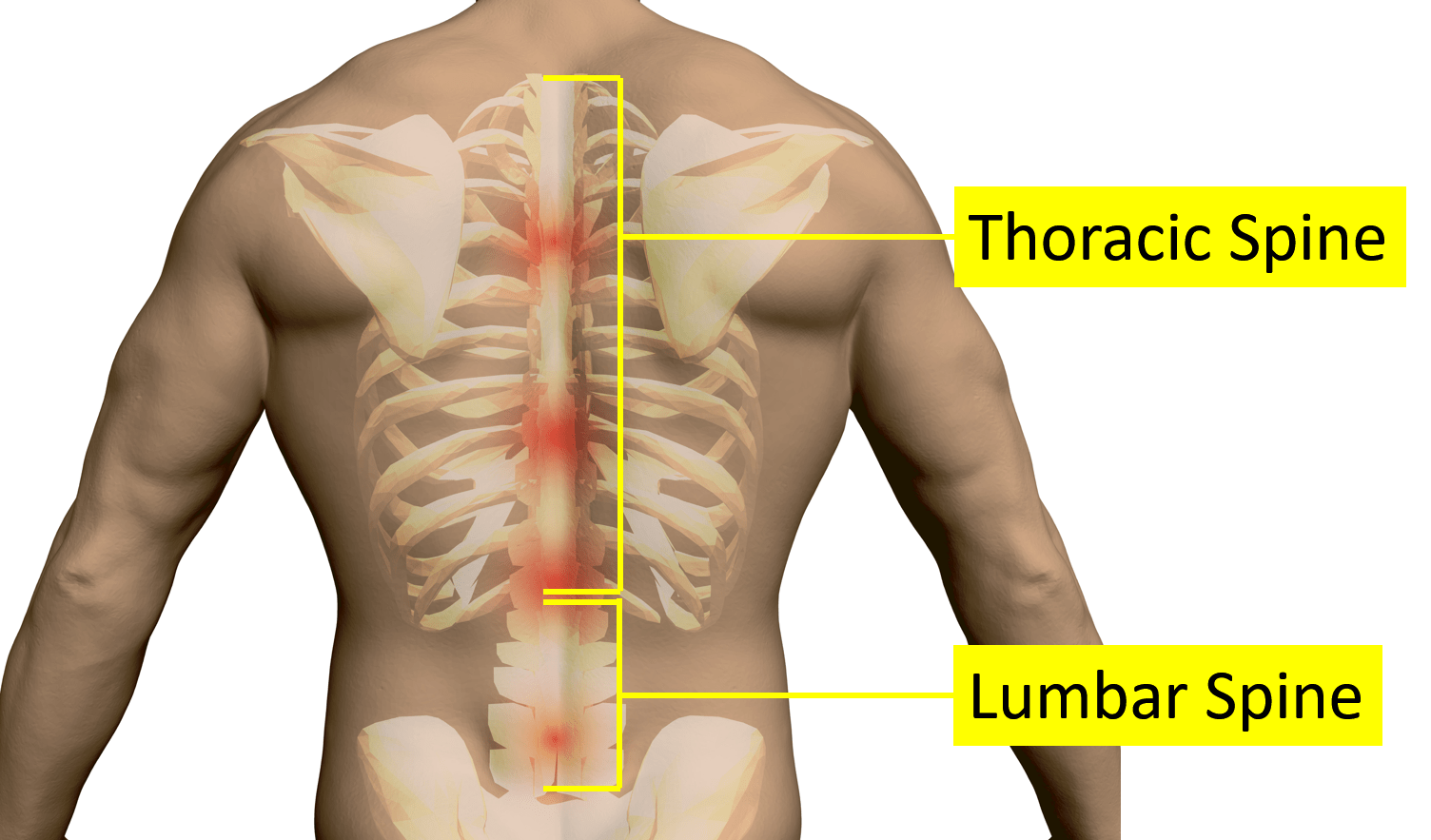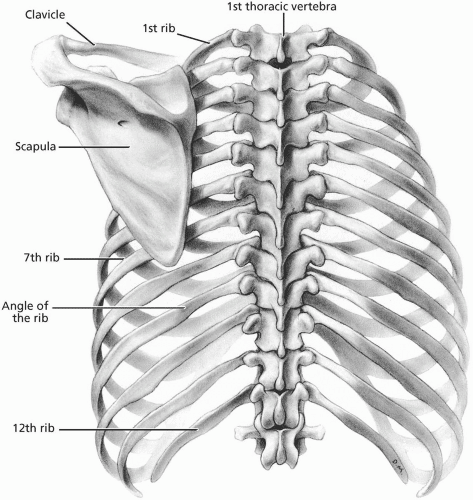What Causes Pain Around the Ribs and Back Symptoms?
In this article:
The thoracic spine and ribs are like a no man’s land for many physicians, including spine experts. While many physicians are comfortable treating and diagnosing neck and low back problems when it comes to things like pain around the ribs and back symptoms, they draw a blank.
First, let’s define what we mean by pain around the ribs and back. Basically, the pain wraps around the back of the rib — generally at least to the side and at times all the way to the front. There is also upper-back pain that often accompanies this pain. Movement usually leads to intense pain or makes it feel like something is “out of place” and needs to be popped back in place. Sometimes specific motions or activities will make this better or worse.
Understanding the Thoracic Spine

The thoracic spine is between the neck (cervical) and the low back (lumbar). Its bones (vertebrae) are numbered 1-12 and the abbreviation ‘T” is used for “thoracic.” Hence, “T6” means the sixth thoracic vertebra (1).
What’s unique is that the ribs attach here to the thoracic vertebrae. These two structures both constrain and define which movements are possible by the other. And because they’re connected, what happens in one is often felt in the other. In addition, the thoracic vertebrae act as pivot points for the ribs as you breathe in and out. This is often why patients experience pain when taking a deep breath.

There’s an immense amount going on in the thoracic spine. First, there are facet joints where the two vertebrae meet. There is a spinal nerve that exists in this area at each vertebra. The nerve begins as the thoracic spinal nerve and then continues all the way around to the front of the chest as the intercostal nerve. There’s a disc that acts as a shock absorber as well as a multitude of muscles and ligaments. Then there are two areas where each rib attaches to each vertebra (the costotransverse and costovertebral joints) (2). Realize that there can be problems with any one of these structures that can cause pain around the ribs and back symptoms.
The Top 5 Causes of Pain In Ribs and Back
Our clinic has had a special interest in the thoracic spine for many years. As an example, most spinal interventionalists have only ever performed a handful of thoracic epidural or facet injections. I’ve done hundreds of each. In all of those years helping patients with pain in ribs and back recover, these are the top five medical conditions that we see in our clinic:
Thoracic Disc Bulge:
The thoracic spine, just like your neck and lower back, has discs that act as shock absorbers for the spinal bones. These can bulge when they get damaged and can press on and irritate spinal nerves. This can lead to pain around the ribs and back symptoms. In particular, this could be just pain or an electrical feeling. There also may be some numbness in the back and ribs.
Rib Facet Pain:
Each rib is attached to its corresponding vertebra at two points with ligaments. Doctors sometimes call these “rib facets.” Technically, they’re called the costovertebral and costotransverse joints. These joints can get damaged and cause referred pain in ribs and back. This pain is often localized to one spot and may get worse with a deep breath. The area may also feel “out of place.”
Thoracic Facet Joint Pain:
The vertebral facets are the joints where each vertebra meets up with the next above or below. These can become injured or get arthritis like any joint and can cause referred pain that is usually in one spot, but pain can extend out beyond the spine as well. This pain isn’t usually influenced by taking a deep breath, but it can be made worse or better with movement.
Fascia Injury:
The ribs have a tough outer covering called the fascia. This covering is there to help control motion. When it gets injured it can allow too much individual rib motion, which can cause upper back pain that wraps around the ribs. This pain is usually influenced by taking a deep breath. You may also be able to identify a painful rib by palpating the area.
Muscle Trigger Points or Areas of Tendinopathy:
You have muscles in your upper back that can develop areas called “trigger points” that can cause upper back pain and pain that refers around the rib. The muscles also have tendons that can get injured and worn out with time, leading to tendinopathy.
How Can The Pain Be Treated? Juan’s Story
Juan’s pain around the ribs and back symptoms with spasms began in 2007, and he presented to our clinic in 2020. Any movement, rotation, or flexion/extension made the pain worse, while rest and medication made the pain better.
Previously, he had tried ozone injections, steroid injections, and facet injections, which provided temporary relief. Radiofrequency ablation at the T8-T11 facet joints provided relief for only about six to eight months. He had also developed tingling in his right ring finger and pinkie, pain in his right elbow, and weakness in his right hand. This was likely coming from irritation of the brachial plexus by his ribs.
We approached Juan’s problems differently, looking at what was causing all of these issues. In particular, one of the ligaments in the back of his spinal canal (ligamentum flavum) was loose and buckling, which was irritating nerves. Hence, we concentrated his own blood platelets (platelet-rich plasma) to inject into that specific ligament to cause some healing and tightening. In addition, we treated the irritated thoracic nerves by injecting a platelet lysate around the nerves (epidural using X-ray guidance).
Finally, his facet joints had previously been treated with radiofrequency, which burns the nerve that communicates pain from the joint. Because of this, nobody had ever tried helping the joint with substances that can promote healing. So again I carefully injected high-dose platelet-rich plasma into those joints using sophisticated image guidance technology. How did he do? He’s reporting 90% relief, with pain only during certain activities.
As you can see, there’s quite a bit that can cause pain around the ribs and back symptoms. The first order of business is getting an accurate diagnosis of why you hurt, which is what we did with Juan. Rather than injecting Juan with steroids that could harm tissue or burn nerves, we focused on the root cause of his problems and tried to improve the function of the spine.
__________________________________________________
References
(1) Thoracic Anatomy. Physiopedia. https://www.physio-pedia.com/Thoracic_Anatomy. Accessed August 12, 2021.
(2) Chopra P. Thoracic Pain. In Smith H. Current Therapy in Pain. Elsevier; 2009:194-201. doi:10.1016/B978-1-4160-4836-7.00026-2

If you have questions or comments about this blog post, please email us at [email protected]
NOTE: This blog post provides general information to help the reader better understand regenerative medicine, musculoskeletal health, and related subjects. All content provided in this blog, website, or any linked materials, including text, graphics, images, patient profiles, outcomes, and information, are not intended and should not be considered or used as a substitute for medical advice, diagnosis, or treatment. Please always consult with a professional and certified healthcare provider to discuss if a treatment is right for you.
